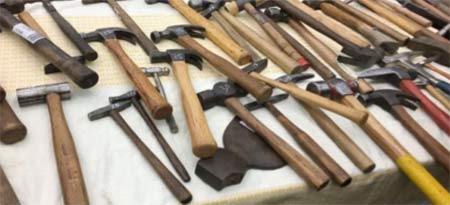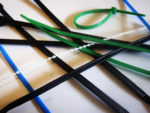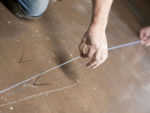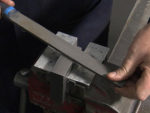This section is all about hand tools – how to use them, what you use them for and all the different types that there are. Hand tools have been around perhaps even before the first humans first walked the earth and they have evolved into thousands of different types and forms. For example there are over 20 different types of hammer that are commonly used in home improvement projects. The same applies for pliers and grips, and saws and most other hand tool.
With this bewildering array of different hand tool, it is hard to know which tool is for which job. Many are designed for a very specific job, while others are generalists with many roles. The key thing is that if you get the right tool it will be much easier to use and you will be much more effective with it.
We have projects in this section to help you to understand the different types of tools and when they should be use, but we also have projects that focus on helping you to use a tool correctly so that you can make the best possible job with it.
When it comes to cutting and drilling we have put the tools and drill bits in particular into a separate Cutting Drilling and Using Drill Bits section. [LINK to follow] Here you will find a wealth of information about drill bits and drilling, which can either be done using hand or power tools.
We have a section all about Power Tools which explains everything you should know about power tools in a similar way. We explain which tool should be used for which job and how to use them safely.
When doing any home improvement project it is not enough to simply have the right tools. It is important to consider your safety and the necessary personal protection equipment that you need for the project you are doing. Also having the correct work wear can make it much more comfortable. Have a look at our section on Safety and Workwear for more information.
The Misuse of Hand Tools
We all misuse hand tools from time to time. Our Master Joiner, Gervase Evans, winces visibly at the sight of anyone opening a paint pot with a chisel! The fact that he has actually invented a pretty handing little chisel sharpener doesn’t seem to make any difference to him!

The reasons not to misuse hand tools (or any tools for that matter) are obvious. To spare your blushes, they are because you could:
- Damage whatever you are working on
- Damage the tools itself
- Damage yourself
All possibly irreparably, but the latter being the most important, of course.
We all know that we shouldn’t do it and why we shouldn’t do it yet, if we are honest, we still do it! Sometimes it”s worth the risk, or doing the project with the right tool in the right way is too much hassle. Here are the most common ‘misuses”, and a couple of gentle reminders about what could go wrong.
The 5 Most Commonly Misuse of Hand Tools
In order of most misused, here are the tools that we, as DIY-ers, abuse more:
Hammers
This is not because the hammer itself is misused, but when using a hammer there is a chance that debris might fly off. There is virtually no situation when a hammer should be used without some form of eye protection.
How many times do you use goggles or safety glasses? Often people actually remove their glasses to see better when striking a hammer!
There’s obviously the damage caused by miss hits and hitting things that shouldnt be hit. Also ensure that the hammer head is firmly secure to the shaft – it can really hurt if it slides down on to your hands.

Screw Drivers
They are just so versatile. You can use a screw driver for almost anything; a wedge, a punch, a leaver or bar, or even turn it around and use it as a hammer!
The issue is that it dulls the blade or can even bend the shaft. That said everyone needs a blunt, old screwdriver to open those pots of paint.
Knives
The misuse of knives comes in many guises and they are the single largest cause of injury while doing DIY. This is mainly a result of not cutting away from the user, or not holding whatever is being cut firmly. This results in a slip and often a nasty cut.
Knives are often misused for jobs that they are not intended; tightening or loosening screws – the fiddly small one in particular, or for scraping or using them to pry things apart. This will blunt the knife or it could slip and cut something or someone.

Chisels
Other than using them to open pots of paint and varnish which will ruin the cutting edge, one of the greatest misuses of chisels is using the wrong chisel for the job. Trying to use one that it either too large or small is common, rather than going and getting the right one, so that only a corner of the blade is used for instance.
Try and resist the urge to use your chisel as a stripping knife or scraper, as this is all it will be good for before too long.
Axes
There are two areas of misuse; firstly people use axes to cut wood that is teetering on the verge of falling over while it is would be safer to take the time to securely place it so that it will not ricochet off when struck with the axe. Secondly, using a blunt act increase the chances of the blade glancing off the wood even more; the axe head or wood being cut could fly off and cause damage or injury.

Top Tips for Using Hand Tools
There are a number of tips you might not already know about using hand tools safely:
- Know what you are doing and how to use the tool for the job – see the projects above, or get in touch if there is something you need to know
- Keep your tools serviceable; regularly inspect them, keep them sharp and well maintained
- Ensure that storing and carrying your tools will not damage them – get a suitable tool bag
- Wear the right protective clothing or personal protective equipment
- Keep tidy; avoid mess and clutter
- Only use insulated tools when working with electricity
- Make sure you are in a stable and solid position before starting to use any tool, particularly one that cuts. Try to cut away from you





















